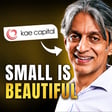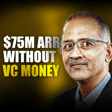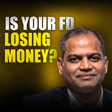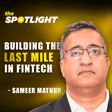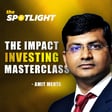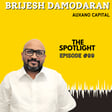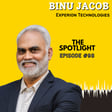Become a Creator today!Start creating today - Share your story with the world!
Start for free
00:00:00
00:00:01

Building Yum! Brands for India | Ghost Kitchens
Ghost kitchens are a hot trend in the food scene, and Karan Tanna, Founder and CEO of Ghost Kitchens, is here to guide you through it. Listen in to learn about how this former automobile engineer and successful F&B entrepreneur launched Ghost Kitchens after scaling and exiting two startups. In this episode, Karan reveals his exciting journey, offers insights into the franchising model and fulfillment partner program, discusses celebrity collaborations, and shares how he bounced back after being forced to shut down his kitchens during COVID.
Transcript
Introduction and Background
00:00:00
Speaker
Hi, I'm Karan Tanna. I am the founder, CEO of Coast Kitchens India. It's a pleasure to be here with you.
00:00:18
Speaker
Let me start with my first question. um Tell me about your journey of becoming an entrepreneur. You became an entrepreneur quite a while back, almost a decade back from what I can make out. So ah how did that happen?
00:00:32
Speaker
ah so Actually, I will start from the start. um you know I was born in a very small town in Gujarat called Vereval. My parents were both entrepreneur entrepreneurs at that time, though not big entrepreneur entrepreneurs, but they were trying to make their living by yeah you know hustling, doing small things. Every couple of years, they had to they to ah change what they were doing.
00:00:55
Speaker
But they were very progressive in their thought process. So now you know they realized that wherever is a small hub, you know me and my younger sister wouldn't get exposure. the So they decided to shift us to Ahmedabad. They left everything, what they had, their social circle,
Journey into Entrepreneurship
00:01:11
Speaker
family. And it's difficult, right, when you don't have you know soundness economically to move the city to a bigger city with your children, education.
00:01:20
Speaker
So they moved to Ahmedabad with me and my sister for our education. and When I was in 9th standard in 1999 and then I did my higher secondary in Ahmedabad and post that I did my automobile engineering from Vithyanagar, which is a small place between Ahmedabad and Baroda, where there are many colleges. ah Post that I worked for General Motors and um then I worked for McKinsey and Company and then I got into entrepreneurship. So, you know, once I shifted to Ahmedabad and while I was growing up, ah you know, we observed that a lot of people are doing business around us and, ah you know, as they say that
00:02:07
Speaker
in Gujarat, businesses in a ah you know entrepreneurship, people talk about and it comes naturally to them. And because I had seen my mom and dad ah doing that journey of entrepreneurship, I never knew that you know why we did not have more money. at Entrepreneurship has those kinds of risks also. But I always saw them putting their you know entire heart in. There was a lot of passion. ah They used to put in day in and day night. And I also saw A lot of my friends, parents, you know, having big cars, big bungalows. So, you know, I connected dots that, you know, there is passion required and then there is success associated with it.
00:02:48
Speaker
So to be honest, both of them attracted me. When, when I started entrepreneurship or when there was a thought of starting entrepreneurship, but you know, unlike a lot of kids and like many kids, I did not have any focus while I was in college, while I was in school. So, you know, i I was an automobile engineer. Now, if someone is asking me or at that point of time, also why you want to be an automobile engineer or why I took automobile engineering as a field.
00:03:19
Speaker
I have no concrete answer to it. you know It just happened. Maybe I did not have any other option at that time, ah depending on the scores that I got. ah so um So, I was never focused on the continuity. My sister was very focused you know from from um the time she was in class 5th.
00:03:35
Speaker
Six, she always used to tell that she wanted to be a lawyer and then she got into the one of the best law colleges in ah India and then she is a successful lawyer in New York. But I was never so focused. so um Similarly, when I started entrepreneur entrepreneurship, I did not have big plans. I did not understand equity, fundraising, value creation.
00:03:58
Speaker
You know, I just thought that I'll start entrepreneurship, it'll be cool, I'll become famous and at some point of time in wherever, in early 90s or mid 90s, my parents used to run a small restaurant called Real Treat and I remember that I used to wait tables on weekends, so they used to dress me up in a blazer and then I used to wait tables, it was a small restaurant.
00:04:22
Speaker
And you know, I saw them putting all their heart into it and then of course that memory remained and then, you know, all of us want to open a cafe at some point of our life. and I wanted to do that ah more than anyone because I had seen my parents do it for a short while. So I quit McKinsey to start a restaurant of my own, ah thinking that I will become famous because I'll own a restaurant. It's glamorous. um So you know we opened a big 180-seater restaurant. Of course, I did not have money to put in, so I partnered with one of my school friends, ah a close friend of mine.
00:04:59
Speaker
And ah you know that's how my entrepreneurship journey started. ah you know I had no plans, I had no vision, I had no concrete skill sets, but just took up lunch into it. On the hindsight, I realized that you know that that is one of the strengths that one should have because the more we know,
00:05:20
Speaker
ah the more we calculate the risk appetite and you know it stops us from taking up lunch and I'm glad that I did not have that much of knowledge, i did I did not have anything to lose and that helped me to take an early plunge and that's how you know my entrepreneurship journey started um with no plan, um with with no intention of being an entrepreneur.
00:05:42
Speaker
um you know In Gujrat we say, that dando k vo you know we want to do Danda. So that was it. and you know I took a leap there and started off.
00:05:55
Speaker
So there's a seven-year journey from ah that first 180-seater restaurant to Coast Kitchens. Tell me about that journey.
First Ventures and Challenges
00:06:04
Speaker
like like ah Each step in that journey must have been like a connecting dot ah through which you eventually realize that Coast Kitchens is what you want to build.
00:06:14
Speaker
Yeah, absolutely. ah you know When we look at hindsight, we realize that this happened for this. um But you know when I started my first restaurant, it was called Goodies, the 180-seater one. And it was one of the coolest restaurants in Ahmedabad. We used to do a lot of stand-up comedy. We used to do a lot of events.
00:06:34
Speaker
It was a franchise of one of the very successful chains from Baroda. So at the time of channeler motors, see again connecting the dots. So when I was in Baroda, when I used to work for channeler motors and every time I used to get down of the bus, there was a nearby restaurant called Budis. So I used to go there and eat samosa as a evening snack and you know that memory ingrained and when we after 3-4 years, ah you know when we started to explore what kind of restaurant we want to do.
00:07:01
Speaker
ah Goodies was the first thing in my mind and we got in touch with their owners and we asked them if they were interested to give a franchise. So, ah you know, they were kind enough, very good family and gave us a franchise in Ahmedabad and we launched it and it ran quite successfully for a year. ah You know, I thought I'll be popular because of Goodies and you know, I was single at that time, so it will give me a lot of avenues, so to say, but you know,
00:07:30
Speaker
A lot of my ah goals were not achieved because sooner than later I realized that this is a 16 hour, 18 hour commitment. It's not easy. ah You need to look into very minute test details. But luckily for me, again with no plan, you know I fell in love with it. I started enjoying the kick of it. I started enjoying when guests used to appreciate the food.
00:07:53
Speaker
ah You know, ah there is a process of marking orders. So, you know, whenever there is a customer order, ah there is a person in the kitchen who will mark the orders to all the sections like the Indian section, pizza section, et cetera. And he will make sure that everything is prepared in time. The food is going out ah together at the time it is supposed to go coursewise, so on and so forth. So I used to enjoy that process a lot. And then I learned nuances of business and fell in love with it.
00:08:23
Speaker
But you know after a year, as fate would have it, me and my partner, who was also my school friend, and ah we did not you know get along on get along well on some of the goals of the business, and we decided to split the business. So because he was a major investor, he retained the retail part of the business, and I took over the commissary or the back-end kitchen. um From there, I hustled. Again, you know money was a problem.
00:08:53
Speaker
So I hustled and we used to supply B2B to a lot of 5-star hotels, to a lot of restaurants, products like breads, puff, etc. But you know all of this is in credit and a collection of money was a big problem and I was 24 that time.
00:09:11
Speaker
So, you know people would wouldn't take you seriously, but in six months, I approached, I used to do sales myself, many times I used to do deliveries myself, packaging myself, but I enjoyed, ah you know I never thought it was a struggle. So, people you know remind me, my friends at some point of time that You know used to do all of this. Remember, you used to deliver at 5 in the morning, 7 in the morning. ah But i I never found it to be a struggle at that point of time. And you know that is the learning again I took. ah Sorry, I'm deviating a bit. And that's why if someone asks me right now that what are the challenges in your business and have you struggled a lot? I always say,
00:09:53
Speaker
ah No, and I always say there are no challenges because after a point, the job of the entrepreneur is to solve a problem. The more problems you solve, the accurately you solve them and the faster you solve them, ah you encounter more problems and then you solve them and then you keep growing. so i think ah the speed of growth or the height of growth is directly proportionate to your ability to solve problems. ah So, you know, that's the learning I got and I never take anything as challenges encountered in business or struggles and encountered in business. So, I enjoyed that journey in six months. I approached a Dabeli chain called Kachikin. So, Dabeli is a Gujarati street food and, ah you know,
00:10:38
Speaker
Very beautiful couple who started this. They were hawkers for part of their lives. larryri chaar e or on on if ka chiing kulata and ah you know they They were very successful, 8, 9, 10 stores when I met them. and ah you know I wanted to sell cows to them, breads to them, but we became friends at a much time.
00:11:00
Speaker
ah you know They were getting a lot of franchise inquiries. They wanted to expand a lot. They thought I could add some value. So, in a month's time, we decided to partner in a bigger way. They were looking out for a centralized kitchen also coincidentally. So, we bartered the kitchen for equity in the company and we grew it to 209 stores from 2013 to 2015.
00:11:22
Speaker
That was one hell of a ride. In the beginning, I was a bit reluctant that you know it's it's a street food that I'll be growing, you know whether it'll be cool, whether I'll enjoy it or not, whether the business will earn me money. ah But of course, you know again, you don't have a lot of knowledge. you You just go by the kick or the expected kick that you'll get out of it. And in in this case, I did not have much choice also because I didn't know what to do after two months, three months.
00:11:52
Speaker
So everything put together, I took the decision and it paved out to be a great decision, a great partnership. You know, again, a lot of people say that never get into partnerships, but you know I would have said that because my first partnership did not work out and I lost a friend also.
00:12:10
Speaker
ah but immediately in six months I got into another and that was very beautiful and I have great relations with them even today. So, ah you know, after growing it for three years, you know, I learned the ropes of how to scale a brand, supply chain, franchising, standardization, training, unit economics, economics for a brand, ah you know, to run a large US chain. And then I got an opportunity to moved to Mumbai and started Yellow Tie Hospitality with in partnership with a company called Franchisee India, which is Asia's largest franchising company. So I spoke to the owners of the chicken and they were kind enough to give me an exit.
Transition to Franchise Management
00:12:54
Speaker
And then I moved to Mumbai. I was given accommodation in their guest house. This was in 2016. And the idea was to make India's first wooden beverage franchisee management company.
00:13:07
Speaker
ah Franchise India is great in selling franchises. They are one of the largest franchise consultants and brokers. And I had some kind of an experience in running the franchising operations. So the owner of Franchise India, Mr. Boromaria, thought it was a good partnership. And so it turned out to be a good one. And in three, three and a half years, so we had a portfolio of eight to 10 brands. We had licenses of a couple of international brands.
00:13:34
Speaker
and we created our own brands. We created brands in partnership with the celebrity chef for Pal Singh Sohki also. And then we scaled to 120 stores in 18 cities in a span of three and a half years. That was the tenure that gave me a bigger vision. I shifted to Mumbai. I started meeting a lot of people. now I started to know how value creation works. I was part of Pope's 30 under 30 entrepreneur, 35 under 35.
00:14:04
Speaker
GQ most influential young Indians. This all forums gave me opportunity to meet other people who have done great in their own fields and learn from them. And then my vision started becoming bigger and bigger. You know, when the kind of background I was coming from and when I started entrepreneurship, I would have thought that you are just didnt patch girl butjae we will you know, it's a good amount to to retire. You know, you can have a happy life. was kind interest for start iga So that was the mentality that I started the business with and you know, that is what I tell a lot of my ah fellow entrepreneurs who are younger that it's not mandatory to have a bigger vision plan or to have larger goals or bigger dreams because
00:14:50
Speaker
Dreams is a factor of you know your exposure and a little bit of a success that you taste. And of course, there is an angle of a whim in your mind which which forms the dreams that that one sees. so But the more and more exposure you start getting, ah you start actually dreaming bigger. ah you know when you When I say that this kind of dreams are those dreams which you know that you can execute, better ah So I started to have bigger dreams, a bigger horizons. And then a coincidentally at that time, ah Franchise India told that it's a great business for us to take forward. Will you be willing to sell it to us? And I had i kind of established myself ah personally in Mumbai. I thought I could sustain a lifestyle in Mumbai or sustain a living in Mumbai. And hence,
00:15:45
Speaker
I decided to sell my stake to them and start Coast Kitchens. so That's how I started Coast Kitchens in the third quarter or second or third quarter of 2019. Before that, I had scaled it to FNB startups and exited both of them successfully.
00:16:05
Speaker
So what one question on what Yellow Tie was doing, why you did you also actually operate any restaurant? So you were just creating a concept of a restaurant and then selling it to franchisees to run it? ah No, we did not operate any restaurant. We created brand, we created SOPs and we you know started giving franchisees. so you're actually ah I mean,
00:16:30
Speaker
without actually running a restaurant, how do you make sure that your SOPs are very polished, your brand is working, that there is product market fit. I mean, you know that ah if you're just selling a franchisee without being sure of product market fit. No, it's a great question. In fact, I'd like to take a and wrote here So, in markets of UK, USA, and I'll particularly talk about food, but it applies to all the other industries. ah Franchising is regulated by government. So, to give you an example that in US, if you want to start franchising your outlet out,
00:17:07
Speaker
you need to have three of your own stores, you need to have three years balance sheet, you need to have profit up to a particular percentage and there is a huge 10 pager report that you need to submit and then the organization or the 11 government body will review that and approve if you can franchise or not and that too they will open up your franchising.
00:17:29
Speaker
sector-wise. ah you know because zaruri ni akiga bomb maybe i've been successful what theny may be yoga so It's quite regulated and that's the reason we have maybe 300-400 francs in the US that have more than 100 stores. ah That's why we have McDonald's coming out of US, KFC, Subbase coming out of US, and all of them have 20, 30, 40, I mean no one has 40,000 but 20, 30,000, 10,000, that's a huge number, of Starbucks.
00:17:59
Speaker
So, ah everyone grew through franchising, right? All these international brands that started before 2000 or 2010 for that matter would have grown all through franchising in a couple of decades after they
Optimizing Restaurant Operations
00:18:12
Speaker
started. And then, of course, because they're adequate capital yeah or they started choosing partner who had adequate capital and started giving multi-unit franchise. you know For example, Starbucks has given a multi-unit franchise to Tata. It's their exclusive franchise partner, but it's still a franchise. So they shifted from single-unit to multi-unit after a couple of decades, but until then it was all single-unit franchise. So franchise is a very, very beautiful tool because
00:18:39
Speaker
In food business, which is a very brick-and-mortar business, ah you need ah not only capital to be invested by someone, that's secondary, but you need a good HR. You need a good human resource at the outlet. And who better than people who will have skin in their game? So, you know, if you see the founder, which is a movie based on Rakor Krock, who is the founder of the McDonald's, as we know today, he was not the actual founder of the McDonald's, but ah you know He was the one who started franchising. He realized that the young couples who have a fire in their belly, hunger, who want to make a mark in society, are great options for him to choose as a franchise because they bring in a lot of ah human element. They bring in a lot of ownership.
00:19:26
Speaker
So, you know, all of this together makes a successful franchise operations, and this is and the right way to go about it. So, yes, if we had run our own stores, ah we would have ah better SOPs, we would have been able to give better intellect ah to the people who ah we give franchises to. Also nowadays the issue is that franchise is taken as a side business. So if someone is successful or
00:19:56
Speaker
and he he wants to or maybe let's say he's working somewhere but he wants to do something on site or there is a ah rich guy whose son is not doing anything and he wants to get the son married. ah So oscofer inte school you get the day so you know the the purpose of franchising are quite skewed these days. So India may companies are also not following right franchising standards like we did not do on our own.
00:20:24
Speaker
ourselves We did not follow the best standard of franchising. and franchise leineneval be ah cares b toracudota And that's why we don't see any franchise-driven chain coming out of India. None of the chains even have 500 outlets you know and sustaining over decades. So ah unless franchise is regulated, we won't see it. And yes, we had our own learnings that we if we had run our outlets,
00:20:54
Speaker
yeah um ko but jata product market fit better for customers and we kept on evolving. When you have not run your outlets on your own, you need to be very very soft and you need to take equal ownership with the first three, four, five franchises because you know you are also learning at their cost so you can't ah refrain from putting money. So we did it that way and that's why more and more people started joining us and we started growing. ah But again, you know connecting the dots, that was my learning and I thought that it would have been great if we could have put
00:21:42
Speaker
our own outlets and grown. And in ghost kitchens, hence, ah we started start putting our own kitchens, running it on our own. Everything was company owned, company operated before we started to branch out to fulfillment partner model. Okay. Okay. Okay. I understood. Sorry. I got a little deviated, but now it's it's interesting. Your insight that India doesn't have any large ah franchise operated brand. um Rebel Foods, which is ah I think the only unicorn in this space, so are they doing franchise-led outlets or is it their own outlets or what is their business model?
00:22:25
Speaker
So, you know, ah the biggest unicorn in this field is actually juvenile foods, Domino's, which is a franchise. So, that's the biggest unicorn in food delivery, right? No one delivers more food.
00:22:42
Speaker
than jubilant foods. and ah you know They are valued at maybe 5 billion right now. so na They are also a franchise of Domino's. You can yeah see the power of systems and that that they utilized and power of brand.
00:22:59
Speaker
ah Rebel Foods again is a unicorn and they are not franchising in India. um They started franchising for a short while but they have stopped now. um They do some franchising in other parts of the world but I am not very sure but as far as I know Rebel Foods runs their own stores.
00:23:21
Speaker
retail as well as cloud. And then they have a brand partnership program where they ah invite other brands to operate out of their kitchens. So they operate three or four models. It's a huge, you know powerful food delivery engine that we that they have.
00:23:37
Speaker
And they are they are, I would say, still trying to figure out the best model ah that they can focus on to scale from here on. So now i as far as I know, ah they would not have a large part of the revenue coming out of franchisee. OK. I understood. OK. So so ah you exited the yellow tie. And I mean, you sold your stake to Franchise India in that.
00:24:05
Speaker
um Was it because you could see this writing on the wall that creating a 500 store chain through franchising will not happen?
00:24:16
Speaker
Not really. We would have hustled and made it happen because a lot of our franchisees were thriving. We knew where we were going wrong. That's a big part that we were not getting carried away by whatever little success we would have got in initial years. We were cognizant of what is happening in international markets, how brands grew. I used to read a lot, talk to a lot of people, and we wanted to make something sustainable.
00:24:43
Speaker
You know why I took an exit is because I was a minority shareholder at that time and then I felt that now I am rightly placed having run two companies, having moved to Mumbai to start something which is wholly owned by me and that's the time when opportunity knocked and you know I thought why not, maybe it's an indication to start something. What is the opportunity that knocked?
00:25:08
Speaker
like like ah know ah fraise india offering footing out by me after to what okay So what was the idea behind ghost kitchens? Like what did you start with? You must have developed a thesis that in the FNB space, this is what will work.
00:25:23
Speaker
Yeah, so ah to be honest, actually, yeah you know, ah I do also invest in startups and I have a lot of founder friends and and we talk about thesis and more and, you know, how will you be different? But to be honest, I did not think about all of these way too much at that time. And I don't even think now ah because in food,
00:25:47
Speaker
ah you know You can't have modes or you can't have thesis. Everything gets proven wrong because of the nature of the industry, the competition ah that kicks in, ah how it changes dynamically in every two years. So at that time, the broader thesis was that food delivery is maturing.
00:26:05
Speaker
um Swiggy, Zomato are penetrating better and ah cloud kitchens can be sustainable on their own because of the kind of volume they can get from food delivery and then there are not many organized companies in this space.
Building and Expanding Food Brands
00:26:20
Speaker
um Maybe if we could learn on how to organically grow on aggregators, which at that time and even now people don't understand that aggregators or food delivery is like e-commerce, right? It's like Amazon, it's like Flipkart.
00:26:35
Speaker
As far as backend is concerned, ah there are algorithms there are there are factors that affects the user experience like your kitchen preparation time or your rider wait time, which also affects the grid optimization of aggregators, of course, customer reviews, of course, ah you know how many orders that customers are required to ah call Somato 4 or Shri G4 because that leverage is their bandwidth.
00:27:01
Speaker
So there are many factors that affects either the consumer or the unit economics of the aggregator. And those factors influence the ranking of a particular brand in that hyper-local area. So if you optimize those factors, your ranking improves and you can get organic top of the funnel or visibility. And then of course, if you improve your catalogs and if you understand how the funnel conversion works, how to convert impressions to menu, menu to cart and cart to order,
00:27:30
Speaker
your code of perhaps ah You win a lot of orders without spending a lot on marketing because that's what people do in e-commerce. They know how to leverage Amazon software in a better way. So, you know that was a difference that I wanted to bring on table.
00:27:49
Speaker
And we did that and very quickly in nine, 10 months, we opened 18 of our kitchens, all bootstrapped in four cities, 15 new brands. And we started to touch order volume of 50,000, 60,000 a month, just in nine months of opening and without spending much on marketing. Number of orders or rupee value of order? No, number of orders. well yeah okay So, you know that's the ah that's the kind of organic or order volume that we started to achieve in 9 months by focusing on these aspects, by understanding how discounting works, how to get better visibility, so on and so forth.
00:28:32
Speaker
So, you know, the thesis was pretty simple that, to you know, the organized food delivery market, our brands where were not many, there was still an opportunity and we could build a large company in this space.
00:28:47
Speaker
Very interesting. So there is this Thrasio in e-commerce space, right which is thrio essentially a house of D2C brands and their strength is that they understand how to optimize your Amazon listing and have more sales through Amazon. So what you're doing is like a Thrasio for their food delivery business, like a household brand where you understand how to optimize your conversion through Zomato Swiggy and be a profitable, high volume business.
00:29:22
Speaker
ah Well, actually, I think Thrasio is not a good example these days. They filed for bankruptcy very recently. And Thrasio used to buy out brands and do it for them. ah We create our own brands. So it's not a comparable actually per se. We are doing what?
00:29:39
Speaker
Rammelfoot started to do and what they're still doing or we we are just creating multiple of our own branch. And you know, I'd like to say now ah that, you know, the way we are evolving and the way we are looking at future, ah we are doing what Yum! branch does, right? We are building ah two, three, four QSR branch in different segments. ah When Yum! branch started growing or when they were penetrating, you know, QSR was the large focus and market when we started. um which wes Did Yum have? they They have Taco Bell, KFC, Visa, like foreign franchisees that they have. No, so Yum! Brands owns these three.
00:30:21
Speaker
ah Globally also, so EMBrinds in the US owns this American company. okay yes So you know ah we we want to be EMBrinds from India ah that has 3, 4, 5 iconic brands in the next decade, ah which have grown through not only cloud kitchens, but also QSR or high street stores.
00:30:44
Speaker
So that's the vision which we have evolved into now. So we would like to call ourselves House of Brands, yes, but not the brands that which are external brands, which we have acquired, which then forcibly we are trying to find synergies. Okay. Okay. okay and Understood. Understood. So let's talk a little bit about how to optimize the funnel on a Zomato or a Swiggy, these aggregators. ah and You said that your key insight was that There is a process in which you can optimize your funnel and thereby win more market shares, be more profitable than people who are running ah a single restaurant or a few restaurants. Compared to them, like you know you can win more market shares by optimizing the funnel. How do you optimize the funnel?
00:31:36
Speaker
Well, you know, it's pretty technical, but I'll try to explain to the best of my capability. ah So, you know, funnel has a lot of metrics or parameters at every stage. It starts obviously with the number of impressions that your ID garners. The number of impressions are dependent on, again, many factors. What kind of discounts are you giving? What what kind of momentum that you have in that hyper-local area? Is there a demand for your ID or not?
00:32:04
Speaker
Now what are the user ratings that you have? What's the SLA? What does ID mean here? ID is like one branch of... Yeah, one one let let's say I have a brand called Starboy Pizza, which is in Bandra, Zomato, so that's one ID. right So it's identified as ah as an ID.
00:32:22
Speaker
Okay. ah One listing. So, you know, what's the demand of that listing? What is the SLA, which is basically a service level agreement that how fast you are delivering. So, owing to all these factors, you build up a top of the funnel, ah which is the impressions.
00:32:42
Speaker
Now, the more impressions you have, the more people see you, which means that while someone is scrolling and they've seen you, ah maybe for two seconds or three seconds, that's called an impression. Now, there is a conversion point. What do you do as the owner of Starboy Pizza to increase the impressions?
00:33:02
Speaker
Like is it based on so what discounts you, like you have to enter discounts on Zomato. So what discounts you enter, is that what you do or what else do you do to increase impressions? Multiple things. So discount is one part of it. And then there are a lot of banners on the page, right? There are taggings like pure which tagging, there are ah tagging like buy one, get one, there are tagging like,
00:33:24
Speaker
ah you know get meals at at reasonable prices during lunch time. So there are different taggings during different meal times. So how to be um to be present in all those taggings. In IPL there would be a different banner or tagging. Then there is an inorganic way of increasing impressions which are advertisements.
00:33:45
Speaker
And then you improve your overall ranking, ah which which is the most organic way to improve the impressions. and you can like If you have a high customer rating score, then your overall. Not only that, if your kitchen preparation time is fast, if your deliveries are faster, if if your customers are not calling the third party aggregators ah more often.
00:34:06
Speaker
ah and your and your demand is more, so various factors contribute to your ranking being better in that area which is a back-end metric cut it and then you have more top of the funnel.
00:34:17
Speaker
Got it take it. So you do all of that, you get more views. Then those views, how do you convert them into, like you said, from views to menu is the first. So I2M, impressions to menu is the first conversion menu. Okay. So that is dependent on various things. so A, your brand record. So if people have seen your brand somewhere on social media, blog or blogging about it,
00:34:41
Speaker
many times on high street, ah then the chances of them ah clicking are higher. ah But again, that's very complex for you to solve because you know that's a factor of external marketing and your brand popularity. Like one would one would like to click Haldiram more than let's say Dada Ka Chole. If someone wants to eat Chole Vatura.
00:35:04
Speaker
So a factor of a brand, then the user rating, ah then the thumbnail picture that you have put, ah then what is the cost for two, which is showing, right? And again, cost for two can be optimized over the period of time. And then there is a delivery time ah mentioned there. So these are four or five things that you can optimize and the discount call out. So, ah you know, brand name is many a times not under your control because either you have it or you're not, but over the period of time, of course, you can build it.
00:35:34
Speaker
but a proper thumbnail, depending on the brand, depending on your DJ, an appropriate discount to call out, cost for two ah ratings and delivery time. These are under your control. So if all of these are optimized well, ah you can create more menu opens. So I2M, then so I2M will assure that people have landed on your menu. So your menu is now open.
00:35:59
Speaker
ah So, now how to make sure that they make a cut. So, um you know, again, it starts with what discount they are seeing after the opening but they open the menu. How is your stacking, how they perceive your menu to be in terms of pricing. So, for example, if your items are, all the costly items are seen before, they will immediately drop out. if That is a price-sensitive customer, which is 80-90% of the customers in India.
00:36:27
Speaker
oh it It is a factor of a smart cataloging. It won't excite them. ah They want to see familiarity. They want to see a margarita 6-inch pizza at 120-130.
00:36:43
Speaker
ah So, they are latched onto the menu and then they go further. Then how are your add-ons? Because add-ons will also help you to increase their ticket size. So, it's a factor of a smart cataloging um and how your combos, you know, everything that falls into a smart menu engineering and cataloging picture such on HEA.
00:37:04
Speaker
our lucrative advertising here. So, owing to all of this, people will make a cart. Now, once they have made a cart, they will only drop out if ah they are not getting the discount that was promised or that they perceived by seeing a call-out.
00:37:20
Speaker
now jafffibaroai fifty percent discount up to 120 on a MOV minimum order value of 199.
00:37:33
Speaker
or uno disco name mil time but la vla c oran kique they are expecting of fifty but of discover your name milta you on themovi touch neway So then you know, a price incentive customer will look for a la c joe because stillability your pain ah so ah then the other factors are ah What's the delivery fee that aggregators are charging? What's the convenience fee that aggregators are charging? And sometimes also choice of payment method. a we availabl um kickard with disowly yeahfeonka image method fi lojata um So you know these are the factors that affect the
00:38:11
Speaker
card to order conversion. So ah many things at each stage and needs to be optimized. it It's actually science. And this is actually the tech and foot tech that people talk about. ah You know, ah ordering on Zomato or anyone providing an ordering app, Rebel or Boxay for us, that's not foot tech. You know, the tech part is understanding how to leverage the algorithm best and smartly change your operations or improve your operations ah so that you can leverage it best. ah That's the tech part of foot tech. So that's the entire journey of funnel from impressions to order. Okay. Okay. Okay. Very interesting. So ah tell me your, ah you know, your first brand that you launched, how did you get this off the ground? Go through that journey a little bit with me.
00:39:02
Speaker
So, you know, actually, I don't remember that journey because once I left Yellow Tide, there was so much of hustle. You know, you can imagine that in nine months before COVID, we opened 18 kitchens in four cities. So I had my team in place and... You were like company-operated kitchens. Yes, yes, yes. And you listed all of them. And each kitchen would have multiple brands operating from? Yes.
00:39:30
Speaker
Yeah, so again, you know, first we started a pizza brand, Starboy Pizza. So we had a very small kitchen. ah thought doa pia kitchenbi starboy piave kula fear soakgikija me jagaka me or deer start ksak Then we New York waffles. Then later kitchens reop we opened a little bigger kitchen. the palethe ma chinese sainta jo bachmemi chinese stuff so on and so forth So it kept on evolving. Again, we did not have any kind of a plan.
00:40:01
Speaker
ah You know, we were just having fun, so to say. We were launching branch without any logic. Of course, there were some logics in hindsight and some kind of rational because of our experience and some data that we used to see. But our decision making was very, very quick. ah You know, again, at that moment, I would say that what we were set out to do, maybe we did not have knowledge, which played in our favor again.
00:40:26
Speaker
And ah we we started mobilizing things very, very fast. So, you know, we did not have a very structured approach. Now we have ah higher stakes. There is a lot to lose. There are investors, though they are all very supportive, but we are ourselves, you know, have learned so much that because a brand launch term, I can give you a 20 pointer plan to launch a brand. or a bit chara like So, the more we know ah you know, the more it takes time for us to launch, but of course, at at right time you need to make right interventions and right approach. So, at that time, bus brands,
00:41:08
Speaker
And the data was telling you which category, like the data told you that pizza is a popular category. So let's launch a pizza where Chinese is the next most popular. So let's launch Chinese. That was what the data was telling. So when I started company, that was very clear that we will launch brands, multiple brands, uh, in all these staple food categories. And when I say staple food doesn't mean regional staple. Uh, uh, what I mean is kejolo jadaka Now my logic again was very, very simple. i did I don't even today don't get into too much of a data to find out which brand to launch because let's say there is a demand supply gap of Sushi today in in Mumbai and you open a Sushi outlet and in the next six months there are five more Sushi players. So all the data was for a toss. So we had kept a very simple logic that Amagar Egg brand, Egg hyper local region, maholdre
00:42:02
Speaker
umm very east mayor a of chinese cold so hamko serfjied andda da se and alaka what week brand said ah my ah ah from that six eight klova the radius So, can we get that danda or not? Is there an overall on ah let's say, Som or Sam in that particular hyper-local area of 4-5 crore of Chinese. If that answer is yes, ah um amongga a no percent market share less pay ah oi local area mean then it was a go for us. And the second metric was that, if the potential is there,
00:42:38
Speaker
so potential he yeah excuse in income So that's why today we don't even have a helpful to brag in our portfolio because we are not confident of that. So, you know, the that this was the idea when I started the company and it still goes on. When I the So, uh, you know, these what are the categories where you have brands
Navigating the COVID-19 Pandemic
00:43:11
Speaker
so far. So are you told me pizza and Chinese and, uh, desert, like waffles, uh, Chinese waffles, momos, we have a brand called momo guy, uh, Biryani, uh, we have a brand called momos and and Chinese. Okay.
00:43:26
Speaker
I mean, you know, ah the Chinese would be smaller in that I mean, only fast-combing items will be there in a mobile brand like fried rice, bollip pops e etc. yeah okay okay And, ah you know, then there is Biryani, then there is Indian food, there is Kachini. Indians would be like North Indian.
00:43:43
Speaker
North India. yeah and then And then now we are starting a South Indian food brand. italy sambatosa So I think these are categories and then there are a couple of other categories. Of course, we have a burger brand in partnership with the celebrity chef, Vikir Athani. And ah there are other categories like sandwiches. And then, you know, we like to explore a category within a category. We are selling a burger of 500 today. ah Can we do a brand of 250 or 300 rupees ticket size burger? a cavo market The answer is yes for that. so
00:44:28
Speaker
instead of rediscovering um ah one more question, it's better to have a brand which targets different demography. And now at this stage, you know, we are not looking at launching more brands, rather we are looking at penetrating improving the efficiency of current brands. Okay. Interesting. So the nine months before COVID you had 18 kitchens, as you said, right? oh Yeah. And then what happened when COVID struck?
00:44:58
Speaker
So, you know, um we were losing money. I was putting it from my own pocket and when Covid struck, you know, ah luckily I am blessed to have a little bit of a gift of making quick back of the envelope calculations. kovibi kobe discussions shall route the numbers calculate out There automatically.
00:45:19
Speaker
So, I soon realized that you know if we have to even if our landlords give us a levy of 1-2 months, I will not be able to pay rental electricity of 18 kitchens other they're over X. So, I decided that said that that same very moment in the last week of March that we are going to shut down everything, save money.
00:45:39
Speaker
ah ja kolega of deking and that played out in our favor. ah But we lost 16 kitchens out of that and we opened only 2 kitchens and in August. So ah jobi nomi named amni yeahta ugly past you mean name may put a wash out toga and then we had to open 2 kitchens.
00:45:58
Speaker
ah But yeah I mean that was what it was and you know I again don't see that as a very pitiful thing that happened with us. hoga But the kitchen was religiously chill and then we thought that now let's grow from here. So that's what happened. That first lockdown, may even the cloud kitchens were not allowed to operate? For a month or so or for 2-3 weeks, yes. There wasn't clarity.
00:46:28
Speaker
um okay okay take it and So you took the bet because this is your own own money that you're putting in and you wanted to conserve cash and so you took a bet to shut everything. ah You would have also lost out on your ah ranking. If you shut it down and then you have to start from scratch and again you'll have to build up the ranking like you know in terms of number of views that you that your brand gets. would that You would have had to start that work from scratch then.
00:46:57
Speaker
Not really from scratch, because you have to do an outlet for your IDS, ranking, etc. So of course, we lose certain part of it, but then it's not that difficult as much as starting from scratch to regain that. Okay, take care, understood. So then what happened? You started back again in August with two kitchens, and you were only Mumbai focus so far.
00:47:23
Speaker
Oh no, we were in 4 seppes, Mumbai, Delhi, Ahmedabad and Pune. So we wound up everything, then the only operations that remained open were Mumbai operations.
00:47:34
Speaker
how did you Like it sounds extremely operationally challenging to run kitchens in four locations and ensure consistency of product. ah Because at the end of the day, you are, it's like running a factory, right? When you run a food business, it's not as easy as let's say a D2C brand. A D2C brand will have some third party manufacturer and they're more focused on marketing, fulfillment, etc. But in your case, you're also manufacturing the product. So how did you manage that consistency across four cities? So we did not actually, um the idea was ah to test out that whether we can run operations in all the cities or not. Because we had done a lot of scalability earlier, we knew how to back end the product and how to make it consistent. But
00:48:27
Speaker
when there is so i want do that How do you What is your learning there? How to back-end the product? what What does that mean, back-end the product? Back-ending the product ah means broadly that at the outlet level, you just assemble the product.
00:48:44
Speaker
So, of whatever the product is supposed to be in terms of taste, consistency comes ready made to the outlet and in outlet you kind of regenerate the product and assemble the product. So, in case of McDonald's, they get their sauces, they get their buns, they get their patties and all they need to do is regenerate patties for frozen sauce, ambient tea and they just assemble it. So, the outlet is ready.
00:49:09
Speaker
Okay. Largely tastes dependently. on I mean, if one has to make a mistake, they will make a mistake, but otherwise this is called as immediate proof model, which means sa he needed to be a the um mistake. nigargra So for him to make a mistake, he will have to be a, ah you know, idiot of a larger order. And yeah then that can be, and then that can, then that has to be controlled by the SOP training program audit program. So the idiots of the largest order can be trimmed down by companies processes and then you back-end the product. So, you know, even in Biryani, a lot of brands have various ways to back-end Biryani. But, you know, the best best way in my opinion is to back-end the Biryani base, Hyderabad base, Lucknavi base, to back-end the protein, Paneer tikka, chicken tikka.
00:50:01
Speaker
ah And then to boil the rice in house, you have a boiler or rosmme process 8 B C. You boil the rice, you put some condiments in the rice while boiling so that you know it has that flavour, the thumb. And then you take biryani base, you take protein, you layer the rice and then your barista is fried again. We will be back in Dojate because you know they have a longer shelf life.
00:50:28
Speaker
So, and then you just assemble it, give it or you see that it gives a consistency asset here. So, because we had done a lot of these things. in the past and and this is a factor of R and&D. It's a longer lead time. Also, it's a factor of minimum order quantity. like casey vendors c hs square one i ah customized the three quantity maggiga It's a factor of having an efficient supply chain. So, we first focused on distribution um because our brands were not that big a brand where you know people were eating in Delhi and then eating in Bombay and then seeing that the food isn't tasting well.
00:51:04
Speaker
We were too early for that and also in our minds we had a luxury that we had a Chinese set or a brand or a food market. So we had a brand launch.
00:51:20
Speaker
ah So in some ways the cost of launching a new brand in port delivery is not high, but to maintain and grow it is of course high. But we were right now in a stage where we wanted to make the distribution first, make teams first, acquire infrastructure and learn how it works and if it's working or not.
Technological Integration and Partnerships
00:51:37
Speaker
ah And then in step two, ah we wanted to back in the products, which we did in later part of 2021 or in the first part of 2021.
00:51:47
Speaker
Okay, okay, okay. So your two kitchens which you restarted with were in Mumbai only? Yes, both in Mumbai. Okay, so waha said what's the journey? So then we raised the seed round. We took money from three angels. One of them was Aries, Mr. Rana Dagobati, who is an actor also. ah Why I mentioned him is that now we are together planning to launch a South Indian food brand, the brand that I spoke to you about. So he will be the partner in that brand and he will help us grow the brand through his brand equity and popularity.
00:52:22
Speaker
So, one of them was him and there were other two angels and we took some money and we started opening more kitchens. ah By mid of 2021, we were again at 6 or 7 kitchens, but these 6-7 kitchens ah were doing the same amount of revenue that 18 kitchens were doing because we had to start the kitchen with a branch.
00:52:45
Speaker
But abi ineari brand scurly the so in some way, you know ah it happened for good, right? yeah kitchen esh thatdo So though kitchen some major holy chaurra give away the dismissari brand and then we started opening other kitchens with all brands. So we took our time. There were learnings that we had. And then we started to back-end the product also, simultaneously. Because you know now was the time. We had tested our product. Now we wanted to grow.
00:53:14
Speaker
ah We learned about aggregators. kukake deliao And now was the time that we decided that product mechanism or consistency was focused on. And then ah I started to realize more and more after Covid, food delivery and restaurants before delivery. manga ah ah because eating out was almost negligible. And then I started to realize that and restaurants are not seeing food delivery as e-commerce. They are just wanting to list on Swiggy Zomato and pray to God that orders are there. And you know they were not getting orders and there were articles all over that food delivery is not profitable. Swiggy Zomato Commission, Jada Chachkar,
00:53:58
Speaker
My logic was that Swiggy Zomato is making a loss. They are making a market for restaurants to have another channel to do business. So I never thought they were charging more commissions, you know. They were charging commissions as low as possible just to survive. Or India, my problem is not for commissions, not of commissions, it's of the ticket size. If the ticket size is higher, if the percentage of commissions is higher, then the market will be higher. So I think it's important to deliver the delivery of the rider and the passenger back end of the country.
00:54:35
Speaker
So, ah we realized that we have this model through which ah we have brides that have generated a lot of orders in Delhi, Pune, Ahmedabad, Mumbai. We understand how to leverage the algorithm algorithm better, how to manage catalogues better, to optimize the funnel. So, how is your strength?
00:54:54
Speaker
ah oni be inna shuruyaas sara so amaripa wobi string pea did level pick them fatterur kana banja um and We were seeing that restaurants were struggling to generate orders from food delivery, but everyone wanted. So we thought that there was an opportunity. So we launched a fulfillment partner program. um near restaurants for here but iak You have underutilized capacities. you have space, people, equipments that are not utilized. ah We have good brands and we can generate more orders for you. So why don't you use our brands? Now we generate orders. Let us do what we are good at. ah You do the last movement fulfillment. ah We have to make the fulfillment of this. We have to make a a
00:55:45
Speaker
So this was the idea of the program that it wasn't a franchise, franchise because they were already doing something. ah Second why it wasn't a franchise is they had to know they to not put any capital in this business. So it was an incremental sale for them. So it sounded like a win-win for everyone. And we launched the fulfillment partner program ah in 2021.
00:56:12
Speaker
ah And then in just a matter of 9 months, 10 months, we grew to 150 partners in 35 cities and you know they were generating incremental profits from anywhere between 40,000 to 80,000 a month. ah So that's how the ah extension of business happened into a fulfillment partner program in order to solve ah this problem in the industry of not being able to understand or look at food delivery as e-commerce and not being able to generate ah organic orders. Very interesting. um What was your model with the fulfillment partner? You would sell them the product and odd what is it or you would share some revenue. You would be responsible for revenue and give them a revenue share. like How does it work?
00:57:05
Speaker
So, we were responsible for collecting revenue. we They were our brands. So, we will pay them 65% of that, 65 rupees.
00:57:19
Speaker
hammarajo perperupe was massively will manage aggregator commissions and marketing. So, we had a moment where the was increased and the marketing was increased. And at 2% percent, we had a lot of jobs. We had a lot of groceries. We had a food cost of 35% to 40%.
00:57:50
Speaker
After they start serving 20-25 orders a day, they might have to recruit an additional manpower. So 5-7% is the cost of additional manpower. So their total cost were anywhere around 42-45 and they used to earn 20% on every order they serve of our brand. So that is how the economics broadly work.
00:58:13
Speaker
Okay. The reason to structure it this way, and here you had multiple options. You could have, for example, said that you don't have to buy the product from me. I will just give you money for assembling. ah That was an option, right? You could have just said, I will give you 30% in which you have your local groceries, your manpower, and that's it. ah And the rest is your profit and I will supply the product. So what made you choose?
00:58:41
Speaker
the option you chose instead of the other option where you ah don't charge them for product. I would say india India made me choose that model because in India, you have people who would take those products and misuse it.
00:58:56
Speaker
dalmaney am solike kuki outlet baby darling accountability is the i yeah who product carivre mea or but behavior again use that that So yeah, skin in the game was one key factor and again, it came from our learnings of dealing with a lot of franchises in yellow tie and before that.
00:59:18
Speaker
okay okay okay very interesting so Generally, this is how a franchising model works. You sell the product to the franchise owner. So typically does this become the main business of the restaurant or does it remain a side business for the restaurant, your fulfillment partners?
00:59:40
Speaker
Well, it depends. ah You know, many partners have started to make so much money from our brands. that on only upate brand kajo bodevo inqueki amara bo lagaia So, you know, many at times they only then focus on this business if the economics of their unit permit them to do so. ah But otherwise they keep on running their business in dial-in and take away and they rely on our brands for ah getting them delivery sales.
01:00:06
Speaker
And ah what if someone is also using your brand for dine-in or take-away? Do they give you a revenue share in that case? or you Because you have no way of knowing, right? If they are also selling Star Wars pizza for dine-in and take-away.
01:00:19
Speaker
No, usually we tell them, we encourage them that you do that, we will help you with placards, menus, and you pay us a minimal royalty of 3% of those sales because we encourage them to earn more money out of our brands and that helps in increasing this ticketivity. So, you know, we make a chunk of marketing for you. That's marketing for us. in orvo wei knivalla So why not give them a structured way of doing it and, you know, ah take very small amount, just smell call again you no nameut lea ah but but you know, it at least it happens in a good way. that ah but it's going to but You would eventually need some sort of maybe a point of sale solution for restaurants who are using
01:01:10
Speaker
yeah your brands for offline, right, for dine-in takeaway. Otherwise, how will you calculate 3% of revenue? Also, so actually, all of this is booked in the software that we give them, right? So ah you give them a point of sale software also, like a pause? Yes, or yes, yes. okay need look okay okay Okay. So, you know, that brings me to a point that in this journey sometime in 2022, we also bought a tech company.
01:01:38
Speaker
ah to build a tech of our own, which helps the partners to know their metrics real-time, their sales real-time, ticketing system to communicate with us, inventory management and ordering system. So, you know, we call it property.
01:01:53
Speaker
and ah we there is My co-founder Harshinder, who ah used to run this tech company of his own, he's an IAM alumni and ah you know started a tech company, grew it, raised money and from investors in Japan. This was a product company or a services company? which you one A product company. What was the product?
01:02:17
Speaker
so Okay, so that way they used to customize products. so I think it's called a services company, exclusively for lack of my knowledge. So ah they used to build products for tech players across the world. So various products. So they had various techs built already, but after COVID, they lost some clients, they lost some subscriptions and it was a friend of mine. We were working on a product together for most agents as a client.
01:02:44
Speaker
And then we decided to merge the companies and Navi is a co-founder also. And now interestingly, we are spinning off the SaaS part into a different entity within Ghost Kitchens. And we will be offering this SaaS to other food delivery companies in India and outside of India.
01:03:01
Speaker
Okay. Interesting. ah what is What is the SaaS market like in the food tech space? i I know of this company called Possist. Possist is largely a point of sale and like like it's for cheap restaurants, right? And we featured Possist on the podcast. So that's how I know about them. um So what you're doing is something similar to Possist or what is like like Subpasses is largely a pause company. ah So in restaurants, the tech is predominantly the pause companies, a paid Puja being the largest one in terms of number of subscribers. Then there is Notpay, which owns a pause called Rista. Then there is UrbanViper, which is known for their integrations with third party aggregators. So there are many pause companies per se, and they also have an inventory management module.
01:03:55
Speaker
but There is a specialized inventory management company called Supply Note, which has grown in the last four or five years. And then there are SaaS for direct ordering, like not .pay,
01:04:09
Speaker
like five which are like Shopify for restaurants. so The tech is predominantly this. There is a huge gap in ah in the restaurant industry specifically in food delivery, ah where there is a need of a tech that helps you optimize your operational metrics. And that's the gap that we will look at filling, which will give them tangible benefits in helping them to generate organic order flow.
01:04:36
Speaker
ah which we used to do for us and we had built it in order to help us and it's working so well and there is a huge gap. No one does this and for anyone to build this, they should also have a deep knowledge of operations and gain experience of operations. So we feel that we have a more here.
01:04:54
Speaker
And Harry has been an entrepreneur always, and you know he would be a great guy. He understands the SaaS market of restaurants. He would be a great guy to build a SaaS business out
Future Goals and Expansion Strategies
01:05:05
Speaker
of it. So we are giving it a shot after survey and R and&D and capitalization.
01:05:13
Speaker
ah what is Give me an example. what What is it that the software will do to bring you operational efficiency? So, you know, I would connect again to the factors of operational metrics and ah the funnel, right? So yeah how is your KPT going? If your KPT kitchen preparation time is going high in last two hours, it will intimate you. It will intimate you the real-time situation of your out of shop. How will it know what is your kitchen preparation? Because it is connected with the Zumato and Sugi app, so it knows when the order was picked up.
01:05:47
Speaker
Yeah. So where does he happen? Pause the point of sale. So it will pull data from everywhere and, uh, uh, throw data at you. And, uh, when the order came in, because the order is coming through Zomato, uh, and it knows when the order was picked up because Zomato will have that data when the rider picked up because Zomato gives live updates to the person who's ordering it. So therefore it knows that gap between orders coming in and riders picking it up. And therefore it knows what is the kitchen preparation time.
01:06:16
Speaker
ah Yes, but also all of this happens through an interface of pause because the somato order comes on a pause and then on pause you mark ah ah order ready and then and then when accept also and then ready also and then when a somato writer picks up the order, it also reflects on your pause.
01:06:37
Speaker
So there is a lot of data that you can pull from pause and then of course you can use data which is on Zomato's Wiki dashboards and emails in order to ah read it and present it in a way that it becomes actionable and then there is a tangible use of the data in operations and you know actually drives revenue or bottom line. So this is just MIS so far. How does it actually become a workflow software?
01:07:06
Speaker
Like to drive operational efficiency, you also need workflow automation, right? This this is just a report, right? This is the report of your kitchen preparation time based on data I've picked up from multiple sources. ah so actually Right now today all the brands are seeing their data on a reactive basis. They see the data tomorrow of today. But let's say if you ah if your area manager or if your store manager is getting an alert that in your store, 30% of items are marked out of stock.
01:07:37
Speaker
ah Then it is upon you to take an action and market in stock, right? Then it is upon the area manager to take action on that. But it is giving you an actionable insight. It's not giving you MIS data that after KPT, it's telling you that in last one hour, your KPT is screwed up, improve it now. So, you know, that's how you take actions and then you see the results and then ah you always value the SaaS that you are using and then you get addicted to it. ka we arehan um again our to stop and let tiaha to quihi takei teto but neoga but now our tot stop pushed threw away outlet And then we see that tech me error and then we find out then it takes a job, but out but outto stock heyi you know, that's how, and I think that's a good tech. The moment you start getting addicted to it because it is driving sales for your bottom line for your customer experience for you. Okay.
01:08:34
Speaker
ah But do you also have workflow automation in this? This is still like real-time reporting. ah In addition to real-time reporting, is there also workflow automation? Can you define what is workflow automation? So I can answer that. in like of you know They would be, say, in McDonald's, there is no caller, like you use the term, i I forget that kitchen, shelter, caller, something. ah mar barka marker mark marker yeah So McDonald's doesn't have a Barker, right? Instead of that, it is automated. ah When the order comes in, it goes to a monitor on the screen where everyone can see what it is. And then you mark that order as delivered or whatever. and
01:09:15
Speaker
ah ah So there is some sort of workflow where human actions are either replaced or enhanced with some sort of software helping you. see What is the next step? What is the next step? What is the next step? So that's called KDS, kitchen display system. And that's a part of POS. So POS companies provide KDS. So you're not competing with POS companies. You're building a layer on top of it.
01:09:44
Speaker
Okay. Understood. Understood. okay and so ah There's no need to reinvent the wheel. If you were to decide to build that, it's like... And pause is very commoditized. What we are trying to do is build over the period of time with a lot of operational insights. And pause is something that you need to use because you want to see everything on the same screen. It is replaceable.
01:10:10
Speaker
ah What we are trying to build will drive revenue for you, will drive bottom line for you and it's not replaceable that easily. Okay, and understood very interesting. Okay, got it. So this is like a insights tool, largely, ah where you get real time insights, which help you make better decisions real time. And like, protect I would say it's more of a CTA tool, a call to action tool, where it's telling you that do this. And it's it's telling you do that by sharing data with you.
01:10:45
Speaker
Okay. Okay. Okay. Understood. Got it. So this of course is, I'm assuming it's a yet to be launched like revenue line. Like you would probably not be ah selling it as associate. Not yet, but very soon. Yes.
01:10:59
Speaker
Okay. okay okay ah Give me some idea about the scale today. How many orders do you process today? What is the ah number of cities that you are presenting? What is the revenue or the GMB or what are the ways in which you measure revenue? ah Help me understand that a little bit.
01:11:18
Speaker
Yeah, sure. so ah now Actually, before that, you know I'll just share our learnings from a fulfillment partner program. Just like franchising, a Fulfillment Partner Program is sharing your brand with someone. And again, through Fulfillment Partner Program, present in publicities, we realize that our brands are well accepted at any of the IPE local area that we open in. um But partners somehow are not able to run the way we want them to run because it's maybe not their full time or their glance change or the lifetime value that we want to extract from them ah gets disturbed because of their own personal plans. So we have decided to go slow on the Fulfillment Partner Program. We will only go with organized players. So we recently did a pilot of one of our burger brands with the Peer Cafe
01:12:10
Speaker
um We have launched a burger brand in Hotel Novatil. So Hotel Novatil in Kolkata is using our brand for increasing food delivery revenue and announced revenue also. ah So we will work with only organized players who can ah help us solve these misses for us because our yield drastically reduces otherwise.
01:12:28
Speaker
And now we are concentrating on growing our brands that have ah emerged as hero brands that we feel have a huge scale that can that can themselves be a few thousand crore brands on their own. So we will open high street stores of those brands. Like I told you in true sense, a target to become young brands of India.
01:12:49
Speaker
and we are launching two to three celebrity brands. We are launching a pizza brand with one of the biggest rappers in India. We are launching a Biryani brand with one of the biggest or the biggest celebrity ships of India. These are all contracts in their final stages and we we might be launching a South Indian brand with the Mr. Randa Daghupati. So, we want to concentrate on building 3-5 QSR come food delivery brands
01:13:22
Speaker
Grow them steadily because we are in no rush. you know It's a brick and mortar business. We need to have excellent unit level economics. ah Target ROI of a year or 15 months for the capital deployed. Target get a very, very high customer recall and customer love. And then we will start growing these brands in other cities. So that's how the future looks for us. ah Currently, we are at an annualized run rate of around 50 to 55 crores.
01:13:52
Speaker
um and and maybe in next what is this up here sikaru is this your revenue or is it the gv there's a difference right Your revenue would be 35% of water fulfillment partner is doing, plus your own kitchen revenue would be 100%.
01:14:10
Speaker
No, so this is ah this is revenue that our branch do. And then when we pay to partners, that's our expense. So we don't ever take it from that revenue. It's our revenue and then partners ever take it kind of a thing. okay okay ah so And we target to this revenue to be around 100 crores annualized in the next 18 months or so. ah We are not profitable right now, but our burn is very much under control. it It's less than a minus 10% debit.
01:14:39
Speaker
and in next maybe eight months to 10 months, we will be profitable. So next one and a half, two years. are For us to build a foundation, we are not going to i mean though we raised a series here recently, we are not going to grow with the rocket speed. ah We are holding on to the money, using it wisely, taking back steps wherever needed, being conscious about the the mistakes that can happen in the future if we grow fast.
01:15:10
Speaker
and focus on building solid brand recall and solid product. So next one, one and a half year is about that, of course, while growing at a steady pace. Okay. Okay. Okay. Interesting. ah When you collaborate with a celebrity to launch a brand, ah you give them some recognition or how does that work?
01:15:32
Speaker
ah know They do get a part of equity for that brand. They also get some revenue share. and ah you know we We want to collaborate with celebrities that look at themselves as co-founders, who don't look at a deal as an endorsement deal. that it up post cutting it and not being it now you know There are and some great examples of celebrities pushing brands like their own.
01:15:57
Speaker
ah So, we want this to this kind of associations to be on similar lines and hence celebrities returns largely come through upside of equity ah which can be multiple acts of ah what they would earn through endorsement of the otherwise. So, they get equity in the mother company or these are separate entities for each of these brands? These are separate entities.
01:16:21
Speaker
Okay. Okay. Okay. i Understood. Okay. Interesting. And ah what is the stake split, generally speaking, like what is the range which you give out to a celebrity, broad range? I think I would say that a substantial minority ah is what we give it out. It's a two digit substantial minority.
01:16:46
Speaker
Got it. Okay. Okay. Understood. You know, there are three elements in this deal, which I always explain. One is the celebrity, of course, which brings in eyeballs top of the funnel. Then second is our company that brings in operational expertise banked with to run it. And the third is the investment ah is also brought by someone in this case, coincidentally, it happens to be our company only.
01:17:11
Speaker
So ah you know it's not two parties. There are three parties represented by two parties. So that's how the deal is structured. and Understood. Two out of those three inputs are coming from your side. Got it. but Right. So we can't be discounted because it's the same company, but there are two things that we bring on table, you know. Right. Right. Right. Right. Okay. Understood. Understood. And what is the plan for ah going offline now? Do you want to go offline only through your own, ah like ah owned and operated stores, restaurants, or do you also want to franchise that out, like the offline journey to fulfillment partners and so on?
01:17:50
Speaker
No, I love franchising. you know it's It's a passion and I have learned a lot about franchising. so ah We would like to franchise it at some point of time but as we discussed earlier, ah first we want to learn on our own, that we want to understand the economics and then we will yeah We will franchise out when we are able to say ah ah no to 9 people out of 10 and choose the right franchise for us who is very passionate, who is giving full time, adequately capitalized, ah no rush to make money so you know and and few other factors. So I think we will franchise it out but we are in no rush only if we find right partners because these are celebrity brands again.
01:18:36
Speaker
ah needs to be handled very carefully and you know someone who understands the value of us being a principal because you know everything said and done you know we are a principal we are ah to call call it bluntly we are the bosses they need to do what we tell them to they need to follow our instructions ah though we might call them franchise partners but they are not partners you know they need to they need to follow whatever we tell them so If someone respects this kind of a relationship, of course, it's very respectful and ah we do understand the value they bring on table. But it needs to be very clear that a principle is a principle and you are coming to a principle and because they know more than you in this particular industry. But, you know, if you forget the essence essence of this after you tie up, then it's redundant. So you need to know who the boss is going to be for next five years or seven years.
01:19:33
Speaker
you want to franchise from a position of strength, which means that have enough track record of profitable outlets to show and ah so on, so that it's a hot franchising option for people and you have a lot of opportunities to select who you want to franchise it out to. and Absolutely, yes. yes okay okay yeah We don't want to franchise to people who want to negotiate on fees or negotiate on contracts and ah so on and so forth.
Advice for Aspiring Entrepreneurs
01:20:01
Speaker
Yeah, you want to be like a subway or a like, you know, change how their franchise got it. Okay. As on date, what is the percentage of revenue coming from your own kitchens? And what is the percentage coming from fulfillment partner kitchens? From our kitchens, it is roughly 60 to 65 percentage. And from fulfillment partners, it is 35 percentage.
01:20:25
Speaker
Okay. Okay. And what do you see that becoming going forward? Like, do you want to scale more on the fulfillment partner side or on like owned and operated self owned and self operated?
01:20:36
Speaker
ah No, we see the ratio going to drifting towards on the operated outlet to roughly 90% or perhaps 95%. And only again, now work with partners or fulfillment partners who are organized, who understand the importance of the partnership. Because you know the last thing that I want to do is not get in on the bandwidth of me and my team.
01:21:03
Speaker
And of course there is capital being deployed, but you know, time is of essence and we don't want to build something which we know is not going to end exponential return in future. ah Okay. Okay. Okay. And you don't want to spoil the brand with like negative reviews because I'm assuming our partners would have more negative reviews than your own kitchens.
01:21:27
Speaker
ah Yes. I mean, ah ah partially on higher than our kitchen. And yeah, we want to avoid doing that. Yeah. Negative reviews, ops metrics, a lot of things. Right. right Got it. okay Okay. Interesting. You know, until now in journey, it made sense, but not anymore. Unfortunately, we know more now. So, you know, it's a restriction. we are Got it, got it, got it. You learnt the hard way, maybe what Rebel Foods is also doing, their own kitchens is what you told me. So they would have also learnt it the hard way, that better to do your own kitchens. Yeah, and they were adequately capitalized and they tried a similar program in Southeast Asia, where they started giving fulfillment partners. I'm not sure if it's still running. Okay, interesting.
01:22:18
Speaker
ah it Are there global examples of celebrity-led restaurants getting scaled? There are quite a few global examples. so One of the recent examples is Mr. Beast Burgers. Then there is a chain called Sides.
01:22:38
Speaker
and which is why this YouTuber is called Sidemen. And then there are a lot of, you know, basketball players, baseball players in the US who have their ah chains, ah which have grown to 500 stores, 1000 stores, Blaze, Pisa is one of those. So there are many, many examples of celebrity led FNB brands that have turned into thousands of stores and maybe billion dollars of business.
01:23:04
Speaker
Okay, okay, okay and sir very interesting. So this is like a ah potential unlock for you to cross that thousand store count. Like you said, India doesn't have any chain, which is more than 500 stores. So this celebrity led approach is one way to cross that mark. Yeah, you know, ah that's been the end since then.
01:23:24
Speaker
Yes, that that's been the aim ah since I started entrepreneurship before 12 years. Though the ways and means have changed too. You know, you try many things, but that's the goal ultimately. So why not to try this ah where in a cluttered market, you can get a brand which people notice and then with your execution capabilities, with your experience, try to give them an experience that they come back ah to you irrespective of who the celebrity is associated. So, you know, you have the topmost celebrity chef associated with the brand and they come into your store and eat a biryani which is not good. ah It rather backfires, right? So, it's a risk. ah But of course there is an opportunity which you would like to test out and see if we could make global brands out of these associations.
01:24:17
Speaker
Amazing. Amazing. Let me wrap up with one final question. ah You know, what's your advice to people who aspire to start their own restaurants? As you said, you know, everyone dreams at one point of time to start a cafe or a restaurant. Like for a lot of people it's about setting up a shack in Goa as their retirement and things like that. so So, you know, what's your advice to people who want to become FNB entrepreneurs?
01:24:41
Speaker
No, I am not someone who likes to give a lot of Gyan, but practically I think you know ah there is something called a passion and the definition of passion is not that exciting you right now, it has to be consistent. So, if you feel that your passion will be consistent and you will have a lot of patience,
01:25:04
Speaker
ah Then this is a business for you because it's a very demanding business and the only thing that can help you make up in the morning and continue doing this business is the passion. ah The second thing is that don't underestimate the capital that will go into this. ah a peajo outlet yeah sha boame con nego lavinne ier but mei laviga or eggx and or ah pea haaga So you know the capital estimation has to be ah fair and the third and most important suggestion that I'd like to give is that if you are really serious about this business, ah take a job somewhere ah irrespective of the salary in a restaurant, in a cloud kitchen and work for six months and see because that is the real test that ah you know you will go through.
01:25:53
Speaker
and why to do it with your own money. So, once you pass this test, once you once you pass this test, once you restaurant by being a customer, right? So it's a simple thing. And if you can do this, I think the chances of success um would increase a lot. Otherwise, you know, just do it and see it for yourself. as out Amazing, amazing advice. Thank you so much for your time, Kannan. It was a real pleasure. Thank you so much, Akshay.



